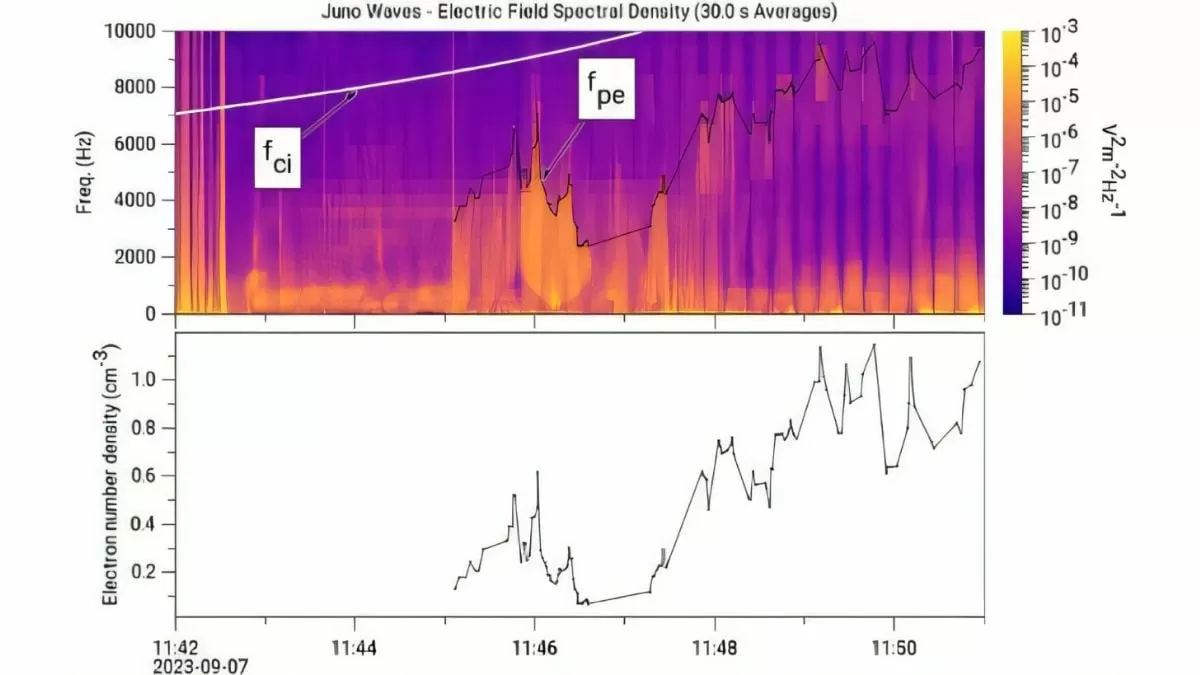The Juno Spacecraft, launched by NASA in 2011, has been on a mission to explore the largest planet in our solar system – Jupiter. Over the years, it has provided us with valuable insights and data about the gas giant, revealing its secrets and mysteries. Recently, the spacecraft has made yet another groundbreaking discovery – the presence of unusual plasma waves at Jupiter’s North Pole. This discovery has been explained by a team of scientists from the University of Minnesota, led by Rober Lysak, and has resulted in the identification of new types of plasma waves.
Plasma waves are a type of electromagnetic waves that are present in the ionized gas or plasma. They are known to exist in various forms in the Earth’s atmosphere and in the space surrounding our planet. However, the discovery of these waves at Jupiter’s North Pole is a first of its kind and has left scientists intrigued.
The team of scientists from the University of Minnesota, along with researchers from other institutions, have been studying the data collected by Juno’s Waves instrument. This instrument is designed to measure the electric and magnetic fields in the space around Jupiter. It was during this analysis that the team came across the unusual plasma waves at the planet’s North Pole.
According to Rober Lysak, the lead researcher of the team, these plasma waves are unlike any that have been observed before. They are characterized by their short duration and high frequency, which is much higher than what was previously thought to be possible in the environment of Jupiter. The team has also found that these waves are generated by the interaction between the charged particles in Jupiter’s atmosphere and its magnetic field.
The discovery of these new types of plasma waves has opened up a whole new realm of possibilities for scientists to explore. It has also provided us with a better understanding of the complex magnetic environment of Jupiter. This is crucial as the planet’s magnetic field is known to be the strongest in our solar system, and its interaction with the solar wind can have a significant impact on the planet’s atmosphere.
The team’s findings have been published in the journal Nature Communications, and it has already garnered a lot of attention from the scientific community. Experts have hailed this discovery as a significant breakthrough in our understanding of the gas giant and its magnetic environment.
Dr. Scott Bolton, the principal investigator of the Juno mission, has expressed his excitement about this discovery. He believes that it is just the beginning, and there is much more to be discovered about Jupiter and its mysterious plasma waves.
The Juno mission has been a collaborative effort between NASA, the Southwest Research Institute, and several other institutions. It has been providing us with valuable data and images of Jupiter, which have helped us unravel some of the planet’s mysteries. The spacecraft has also been instrumental in studying the planet’s auroras, its atmosphere, and its magnetic field.
The presence of these unusual plasma waves at Jupiter’s North Pole is yet another feather in the cap for the Juno mission. It has once again proven the spacecraft’s capabilities and its importance in furthering our knowledge about the solar system.
The team of scientists from the University of Minnesota has set a new benchmark with their discovery, and it has opened up new avenues for future research. They are now working on analyzing the data from other instruments onboard Juno to gain a better understanding of these plasma waves and their impact on Jupiter’s atmosphere.
This discovery is a testament to the power of human curiosity and the determination of scientists to unravel the mysteries of our universe. It is a reminder that there is still so much to be discovered and understood, and we must continue to push the boundaries of our knowledge.
In conclusion, the presence of unusual plasma waves at Jupiter’s North Pole, detected by NASA’s Juno Spacecraft, has been a groundbreaking discovery. The team of scientists from the University of Minnesota, led by Rober Lysak, has identified new types of plasma waves, which has opened up new avenues for research. This discovery has once again highlighted the importance of space exploration and the need to continue our quest for knowledge about the vast universe we live in.

